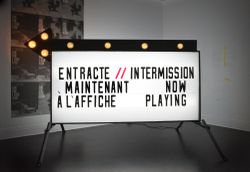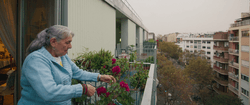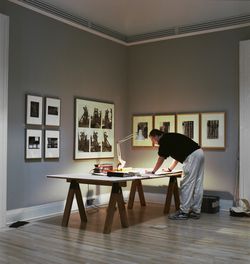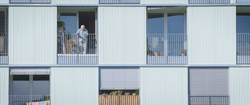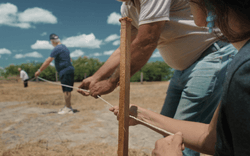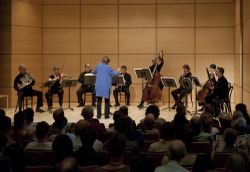The CCA galleries are transformed into cinematic screening rooms to present a range of artistic, scientific, and experimental films on speed and space. Selected by curators from the archives of NASA, the Smithsonian National Air and Space Museum (NASM), the National Film Board of Canada (NFB), and UbuWeb, the films explore the impact of velocity and technology on our(...)
Main galleries
25 November 2009 to 28 February 2010
Intermission: Films From a Heroic Future
Actions:
Description:
The CCA galleries are transformed into cinematic screening rooms to present a range of artistic, scientific, and experimental films on speed and space. Selected by curators from the archives of NASA, the Smithsonian National Air and Space Museum (NASM), the National Film Board of Canada (NFB), and UbuWeb, the films explore the impact of velocity and technology on our(...)
Main galleries
Over three evenings on 15-17 August, join us for free outdoor Inuit games, stories, food, and films, in parc Baile as part of the 4th edition of the Tillitarniit festival. Organized by Inuit visual artist and filmmaker asinnajaq, this year’s festival titled home, body, land will bring together Inuit artists and filmmakers who are shaping todays world with stories from(...)
15 August 2024 to 17 August 2024, 6pm
Tillitarniit at CCA – home, body, land
Actions:
Description:
Over three evenings on 15-17 August, join us for free outdoor Inuit games, stories, food, and films, in parc Baile as part of the 4th edition of the Tillitarniit festival. Organized by Inuit visual artist and filmmaker asinnajaq, this year’s festival titled home, body, land will bring together Inuit artists and filmmakers who are shaping todays world with stories from(...)
Where—and how—do we want to live as we grow older? Will our neighborhoods, our buildings, our cities be able to meet our needs? The evening begins with a screening of the documentary Where We Grow Older (CCA, 2023, 30 min), which explores how architecture and urban planning can respond to the challenges of an aging population. The screening will be followed by a(...)
Paul-Desmarais Theatre
5 February 2026, 6pm
Film and conversation: Where Will We Grow Older?
Actions:
Description:
Where—and how—do we want to live as we grow older? Will our neighborhoods, our buildings, our cities be able to meet our needs? The evening begins with a screening of the documentary Where We Grow Older (CCA, 2023, 30 min), which explores how architecture and urban planning can respond to the challenges of an aging population. The screening will be followed by a(...)
Paul-Desmarais Theatre
photographs
ARCH284977
Description:
The slides were developed by CCA, around 1997, from a film. Slides showing landscapes and trees images.
circa 1947-2002
Slides from an unidentified film
Actions:
ARCH284977
Description:
The slides were developed by CCA, around 1997, from a film. Slides showing landscapes and trees images.
photographs
circa 1947-2002
Architecture and Its Image examines the complex relationships between drawings, photographs, prints, and other architectural representations and the buildings, landscapes, and cities they represent. The exhibition assembles images dating from the early sixteenth century to the late twentieth century from Tokyo and Rome to Mississauga and Montreal and includes maps, books,(...)
7 May 1989 to 7 August 1989
Architecture and Its Image
Actions:
Description:
Architecture and Its Image examines the complex relationships between drawings, photographs, prints, and other architectural representations and the buildings, landscapes, and cities they represent. The exhibition assembles images dating from the early sixteenth century to the late twentieth century from Tokyo and Rome to Mississauga and Montreal and includes maps, books,(...)
Where We Grow Older
The documentary Where We Grow Older (CCA, 2023, 30 min) looks at how the growing ageing population is reshaping architectural and social constructs and questions the role of urban design and politics in facing these challenges. The film investigates two models of how care and housing can be reconceived in light of prolonged lives: public housing and the creation of a new(...)
Where We Grow Older
Actions:
Description:
The documentary Where We Grow Older (CCA, 2023, 30 min) looks at how the growing ageing population is reshaping architectural and social constructs and questions the role of urban design and politics in facing these challenges. The film investigates two models of how care and housing can be reconceived in light of prolonged lives: public housing and the creation of a new(...)
What It Takes to Make a Home
The CCA film What It Takes to Make a Home (2019) follows a conversation between architects Michael Maltzan (Los Angeles) and Alexander Hagner (Vienna), who address the question of homelessness through various projects.
October 2019
What It Takes to Make a Home
Actions:
Description:
The CCA film What It Takes to Make a Home (2019) follows a conversation between architects Michael Maltzan (Los Angeles) and Alexander Hagner (Vienna), who address the question of homelessness through various projects.
articles
Making Groundwork
Forces of Friction
6 October 2025
Forces of Friction
Although it has hosted concerts in the past, the Paul-Desmarais Theatre is better known for holding conferences and film screenings. Concerts traditionally held in the historic Chapelle historique du Bon-Pasteur will temporarily take place at the CCA and music will be reintroduced in the theatre, initiating new perceptions of sound, and of this space. Mindful of the(...)
Paul-Desmarais Theatre Keyword(s):
CCA, Chapelle historique du Bon-Pasteur, concerts, chamber music, classical music, up-and-coming musicians.
31 January 2024 to 17 May 2024
Chapelle historique du Bon-Pasteur Concerts
Actions:
Description:
Although it has hosted concerts in the past, the Paul-Desmarais Theatre is better known for holding conferences and film screenings. Concerts traditionally held in the historic Chapelle historique du Bon-Pasteur will temporarily take place at the CCA and music will be reintroduced in the theatre, initiating new perceptions of sound, and of this space. Mindful of the(...)
Paul-Desmarais Theatre Keyword(s):
CCA, Chapelle historique du Bon-Pasteur, concerts, chamber music, classical music, up-and-coming musicians.
Everlasting
A film from the CCA’s 2023-2024 Indigenous Land Restitution Research Creation Fellow, multidisciplinary Haudenosaunee artist Iako’tsi:rareh Amanda Lickers.
Shaughnessy House
25 September 2025 to 23 August 2026
Everlasting
Actions:
Description:
A film from the CCA’s 2023-2024 Indigenous Land Restitution Research Creation Fellow, multidisciplinary Haudenosaunee artist Iako’tsi:rareh Amanda Lickers.
Shaughnessy House
